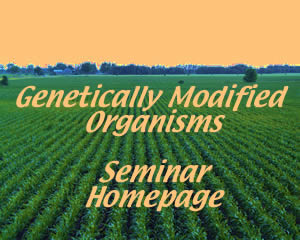|
Benefits |
*This web page was created by Lane Estes and Graham
Watson for Biology 361, an undergraduate course at Davidson College* |
Image courtesy of http://www.hinduonnet.com/thehindu/seta/2002/04/04/images/2002040400010301.jpg |
The majority of genetically modified crops released into production by giant agricultural biotechnology corporations such as Monsanto and Novartis have been herbicide tolerant and/or pest resistant versions of crops. Since the mid 1990’s, the manufacturers of these transgenic plants have launched multi-million dollar advertising campaigns, which convey pesticide resistant crops as a cost effective alternative to traditional crops that will lead to higher yields through improved pest control (Barton and Dracup, 2000). Also, these advertisements purport these new pesticide resistant crops to be environmentally friendly (Mendelson, 1998). However, Non Government Organizations such as Greenpeace and Friends of the Earth argue that these advertisements are “gross misrepresentations of the truth” and offer evidence to counter the supposed benefits of pesticide resistant crops (Mendelson, 1998).
Yield Data
Monsanto states that farmers using pesticide resistant crops as opposed
to traditional versions have reported significant yield increases at harvest
time. This claim is supported by published reports which state farmers in
both the United States and Canada have experienced an average yield increase
of 7% in 1997 after planting Bt corn.
Activists opposed to pesticide resistant crops attest that these transgenic crops have “disastrous performance problems” (Mendelson, 1998). This statement is based upon the fact that many farmers growing Roundup-Ready cotton in the Mississippi Delta reported total crop failure due to cotton boll malformation and premature stalk separation (Mendelson, 1998). Theses same activists also cite scientific studies, which show that Roundup inhibits nitrogen fixation in plants, and estimate that this reduced nitrogen fixation could lead to reduced future yields.
Despite evidence of poor crop performance in some areas, the amount of land used to grow pesticide resistant crops has increased from 3.2 million hectares in 1996 to 20 million hectares as of 1998. Also, there were 800,000 acres of Roundup-Ready cotton planted in the United States as of 1998, just one year after widespread performance problems with that crop (Barton and Dracup, 2000).
Pesticide Usage
A centerpiece of Monsanto’s advertising campaign is the assertion
that genetically modified crops will significantly reduce the volume of
pesticides and herbicides used. Numerous published facts support this assumption.
In Australia, pesticide use on Bt cotton crops has been reduced by 50%,
while American farmers report a 30% decrease in insecticide use on Bt corn
(Levidow, 1999). This is due to the fact that Bt crops constantly emit their
own insecticide in the form of the Bt protein crystal. This eliminates the
need to spray insecticides designed to kill the same pests that are susceptible
to Bt. Also, studies show that American farmers have reduced the total volume
of herbicide used by 50% since the advent of Roundup-Ready crops (Barton
and Dracup, 2000). When Roundup, a broad-spectrum herbicide, is sprayed
on a field of Roundup resistant crops, the farmer is able to effectively
kill all the weeds in a field with a minimal amount of sprayings without
harming the crops.
Individuals determined to stop the spread of genetically modified crops claim that corporations such as Monsanto are using genetic engineering as a means to “dramatically increase the use of herbicides on crops”. These people cite Roundup’s recent annual growth rate of 20% as proof that farmers are increasing their use of herbicides (Franz, 2001).
While these activists are correct in their claim that Roundup usage is significantly increasing, they fail to realize that the increased use of Roundup is a direct result of farmers using Roundup as the lone substitute for many different spray intensive insecticides. As a result, the amount of Roundup used per year continues to increase, but the overall volume of herbicides is decreased.
Economics of Pesticide Resistant Crops
The mentioning of Roundup as a substitute for multiple herbicides ushers
in the next point of discussion. The ultimate selling point of the agricultural
biotech companies who make pesticide resistant crops is the cost effectiveness
of their transgenic products. Many farmers state that pesticide resistant
crops greatly simplify the process of weed management, thus lowering the
costs associated with pesticide application.
When treating traditional crops with herbicides, several different herbicides are typically applied multiple times during specific times intervals of the growing season to kill specific weeds. Also, farmers repeatedly till the soil with expensive farming equipment to plough weeds under the soil. However, when treating Roundup-Ready crops with herbicides, a single herbicide, Roundup, can be applied once or twice at any time during the growth season to effectively control weeds. Also, no tilling of the soil is required to combat weed growth. This reduction in soil tillage as a result of using Roundup has been shown to increase the biodiversity of birds in the areas surrounding the farmland because the weeds are not killed until later in the growing season. Additionally, Bt crops drastically reduce the amount of insecticides needed to ensure crop growth (Firbank and Forcella, 2000). Farmers in the United States reported a net gain of 92 million dollars in 1998 due to reduced on-farm costs after switching to pesticide resistant crops (Barton and Dracup, 2000).
Environmental Benign?
The Agrochemical companies that manufacture both Roundup-Ready and Bt crops insist that these products are environmentally friendly and will help reduce pollution due to pesticides. Monsanto states that Roundup is “safe for humans, pets and wildlife, and is benign to the environment” (Mendelson, 1998). Monsanto cites scientific studies, which have shown that the amount of glyphosate, the active ingredient in Roundup, is harmless to humans and other animals. Also, Monsanto affirms that glyphosate is “rapidly inactivated in soil” and resists leaching into the water supply (Mendelson, 1998). When compared to other pesticides, Roundup is known to have a very low rate of leakage into the water system due to its tendancy to bind to soil (Firbank and Forcella, 2000). This is an important point since fields of Roundup-Ready crops are sprayed almost exclusively with the herbicide Roundup. Additionally, agrochemical corporations’ state that Bt is relatively harmless to humans because the human body lacks the digestive enzymes needed to dissolve Bt protein crystals into their active form (Swadener, 1994).
While glyphosate may be relatively harmless, activists opposed to pesticide resistant crops contend that the inert ingredients of Roundup are known to cause a variety of health problems including skin and eye irritation, vomiting, gastrointestinal problems, pneumonia, destruction of red blood cells, and clouding of consciousness. Studies show that just 200 ml of ingested Roundup is fatal to humans (Mendelson, 1998). Additionally, activists dispute the safety of Bt by stating that Bt is closely related to Bacillus anthracis, the bacterium responsible for anthrax. Also, Bt is toxic to mammals when injected into the brain or abdomen (Swadener, 1994). Due to the continued voice of Non Government Organizations stating the danger of Roundup and Bt, the manufacturers of Roundup-Ready crops and Bt have been forced to withdraw the phrase "environmentally benign" from all of their advertisements (Mendelson, 1998). While Roundup-Ready crops and Bt crops keep the agriculture industry dependent on the usage of pesticides which are harmful to the environment, it must be stated that Roundup-Ready and Bt crops have reduced the deleterious effects of pesticides on the environment by decreasing pesticide use.
© Copyright 2002 Department of Biology, Davidson College, Davidson,
NC 28035
Send comments, questions, and suggestions to: laestes@davidson.edu
or grwatson@davidson.edu


